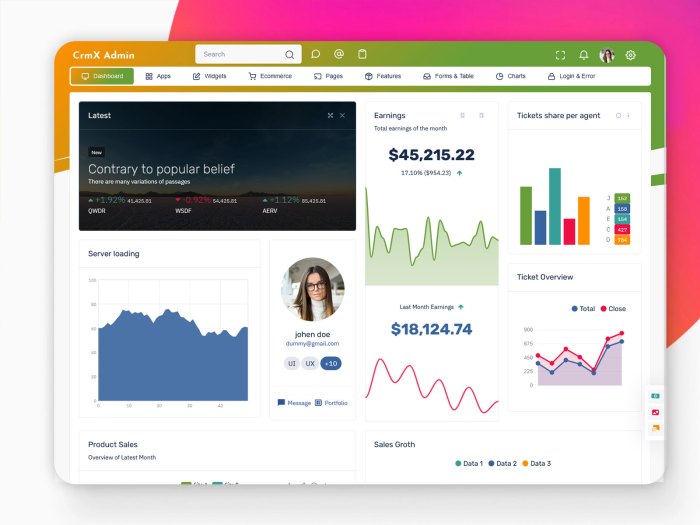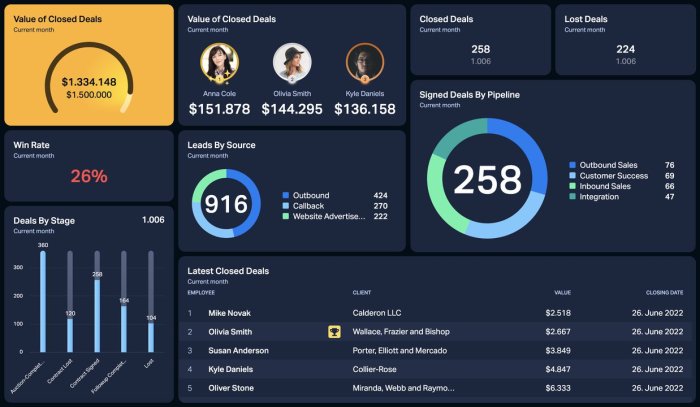CRM software with customizable dashboards revolutionizes how businesses manage customer relationships. This powerful combination empowers users to tailor their CRM experience, optimizing workflows and maximizing productivity. By offering personalized views of crucial data, customizable dashboards enhance user satisfaction and drive better decision-making. This exploration delves into the features, benefits, and implementation considerations of this transformative technology.
From understanding the core features of customizable dashboards to exploring the diverse data visualization options and the importance of robust security measures, we’ll cover all aspects. We will also examine the impact on user experience, the integration capabilities with other business tools, and the critical factors to consider when choosing the right CRM software. This comprehensive guide aims to equip readers with the knowledge necessary to harness the full potential of customizable CRM dashboards.
Customizable Dashboards in CRM Software
Customizable dashboards are transforming how businesses interact with their CRM systems. Moving beyond pre-defined views, they empower users to tailor their workspace, improving efficiency and data analysis. This exploration delves into the features, benefits, and implementation of customizable CRM dashboards, examining their impact on user experience, data visualization, integration capabilities, security, and the process of selecting the right CRM software.
Defining Customizable Dashboards in CRM Software
A customizable CRM dashboard offers users the ability to personalize their view of key performance indicators (KPIs) and other relevant data. Unlike static dashboards, they provide flexibility and control over data presentation and access.
- Core Features: Drag-and-drop interface for widget placement, selection from a library of pre-built widgets (charts, graphs, tables, etc.), filtering and sorting options, the ability to create custom reports and visualizations, and real-time data updates.
- Benefits over Pre-defined Dashboards: Increased user productivity through personalized views, improved data analysis by focusing on relevant metrics, enhanced user satisfaction due to control and personalization, and better decision-making based on tailored data insights.
- Customization Options: Widgets offering different data representations (e.g., bar charts for sales, pie charts for customer segmentation, line graphs for trend analysis), various layouts (single-column, multi-column, tiled), and the choice of data visualizations tailored to specific needs.
- Technical Aspects: Most modern CRM dashboards utilize intuitive drag-and-drop interfaces for ease of use. Some advanced systems may offer scripting capabilities (e.g., JavaScript) for highly customized visualizations and integrations.
Impact of Customizable Dashboards on CRM User Experience, CRM software with customizable dashboards
The ability to personalize a CRM dashboard significantly enhances user experience, leading to increased productivity and satisfaction.
- Improved Productivity and Efficiency: Users can quickly access critical information, reducing time spent searching for data. Personalized views ensure that only relevant information is displayed, minimizing distractions and maximizing focus.
- Role of Personalization: Personalization fosters a sense of ownership and control, increasing user engagement and satisfaction. Users feel more empowered when they can tailor their workspace to their specific needs and workflows.
- Customizable vs. Fixed Dashboards: Customizable dashboards offer a significantly improved user experience compared to fixed dashboards. Fixed dashboards often present irrelevant information, leading to frustration and reduced efficiency. The flexibility of customizable dashboards caters to individual user preferences and roles, resulting in a more streamlined and intuitive workflow.
- Customizable Dashboard UI Design: A well-designed customizable dashboard would feature a clear navigation menu, intuitive drag-and-drop functionality, a searchable widget library, options for saving and loading custom dashboard configurations, and clear visual cues to indicate data updates and potential issues.
Types of Data Visualizations in Customizable CRM Dashboards
Effective data visualization is crucial for interpreting CRM data. Various visualization types cater to different data types and analytical needs.
- Common Data Visualization Types: Bar charts (comparing categorical data), pie charts (showing proportions), line graphs (displaying trends over time), scatter plots (showing correlations between variables), and geographical maps (visualizing data geographically).
| Visualization Type | Sales Performance | Customer Engagement | Support Ticket Resolution |
|---|---|---|---|
| Bar Chart | Effective for comparing sales across different regions or products. | Effective for comparing engagement metrics (e.g., website visits, social media interactions) across different customer segments. | Effective for comparing resolution times across different ticket categories or support agents. |
| Pie Chart | Effective for showing the proportion of sales contributed by different products or sales channels. | Effective for showing the proportion of customers in different engagement levels. | Effective for showing the proportion of tickets resolved within different timeframes. |
| Line Graph | Effective for showing sales trends over time. | Effective for showing customer engagement trends over time. | Effective for showing support ticket resolution trends over time. |
| Scatter Plot | Effective for identifying correlations between sales and other variables (e.g., marketing spend). | Effective for identifying correlations between customer engagement and other variables (e.g., customer lifetime value). | Effective for identifying correlations between resolution time and other variables (e.g., ticket complexity). |
- Examples of Effective and Ineffective Visualizations: A well-designed bar chart clearly shows sales figures for each region, while a cluttered chart with too many data points is ineffective. A simple line graph illustrating sales trends over time is effective, whereas a complex graph with unnecessary details is not.
- Visualizing CRM Metrics: Sales performance can be visualized using bar charts comparing sales by region or product. Customer engagement can be shown using line graphs illustrating website traffic or social media interactions over time. Support ticket resolution can be tracked using a bar chart showing resolution times.
Integration Capabilities of Customizable CRM Dashboards

The value of a CRM dashboard is significantly enhanced by its ability to integrate with other business applications.
- Importance of Integration: Integration allows for a holistic view of business performance by consolidating data from various sources into a single dashboard, providing a more comprehensive understanding of business operations.
- Data Consolidation: Data from different sources (e.g., marketing automation, e-commerce platforms, accounting software) can be combined and displayed on the dashboard, providing a unified view of key metrics.
- Integrations with Business Intelligence Tools: Popular BI tools like Tableau and Power BI can be integrated to provide advanced analytics and data visualization capabilities.
- Potential Data Sources: Marketing automation platforms (e.g., HubSpot, Marketo) provide marketing campaign performance data; e-commerce platforms (e.g., Shopify, Magento) offer sales and customer data; accounting software (e.g., Xero, QuickBooks) provides financial data; and social media platforms (e.g., Facebook, Twitter) provide customer engagement data. Each source has its own benefits and limitations in terms of data accuracy, completeness, and accessibility.
Security and Access Control in Customizable CRM Dashboards

Protecting sensitive data displayed on customizable dashboards is paramount.
- Security Measures: Data encryption both in transit and at rest, secure authentication mechanisms (e.g., multi-factor authentication), regular security audits, and intrusion detection systems are essential.
- Role-Based Access Control: Different user roles (e.g., sales representatives, managers, administrators) should have access only to the data and functionalities relevant to their roles. This prevents unauthorized access to sensitive information.
- Best Practices for Securing Dashboards: Regular software updates to patch security vulnerabilities, strong password policies, and employee training on security best practices are crucial.
- Auditing User Activity: Tracking user logins, data access attempts, and modifications made to the dashboard is essential for detecting and investigating security breaches.
Choosing the Right CRM Software with Customizable Dashboards
Selecting the appropriate CRM software requires careful consideration of several factors.
- Comparison of CRM Platforms: Salesforce, HubSpot, and Microsoft Dynamics 365 offer robust customizable dashboard features, each with its own strengths and weaknesses in terms of ease of use, customization options, and integration capabilities. A thorough comparison based on specific business needs is essential.
- Checklist for CRM Selection: Consider factors such as the ease of dashboard customization, the available data visualizations, integration capabilities with other business applications, security features, scalability, and pricing models.
- Pricing Models: CRM software typically offers different pricing models, including subscription-based pricing (per user, per month), tiered pricing based on features and functionality, and custom pricing for enterprise-level deployments.
- Implementation and Training: Successful implementation requires careful planning, data migration, user training, and ongoing support. Adequate training ensures users can effectively utilize the customizable dashboard features.
Closure
Ultimately, CRM software with customizable dashboards represents a significant advancement in customer relationship management. The ability to personalize data visualization, streamline workflows, and enhance user experience offers unparalleled benefits. By carefully considering the factors discussed—from security protocols to integration capabilities—businesses can leverage this technology to optimize their operations, improve team performance, and ultimately, drive greater success. The flexibility and efficiency gained through tailored dashboards make them an invaluable asset in today’s dynamic business landscape.
FAQ Resource: CRM Software With Customizable Dashboards
What are the limitations of customizable dashboards?
While offering great flexibility, over-customization can lead to inconsistency across teams and potential data overload. Poorly designed dashboards can hinder, rather than help, productivity. Careful planning and user training are crucial.
How much does CRM software with customizable dashboards cost?
Pricing varies widely depending on the software provider, features, and number of users. Options range from free, open-source solutions to enterprise-level platforms with substantial monthly or annual fees. Consider your budget and specific needs when selecting a solution.
Can I integrate my existing data with a customizable CRM dashboard?
Most CRM systems offer integration capabilities with various data sources. The specifics depend on the software chosen and may require custom development for complex integrations. Look for APIs and pre-built connectors for seamless data flow.
What security risks are associated with customizable dashboards?
Improperly configured dashboards can expose sensitive customer data. Implementing robust access controls, data encryption, and regular security audits are crucial to mitigate these risks. Choose a reputable vendor with strong security practices.
